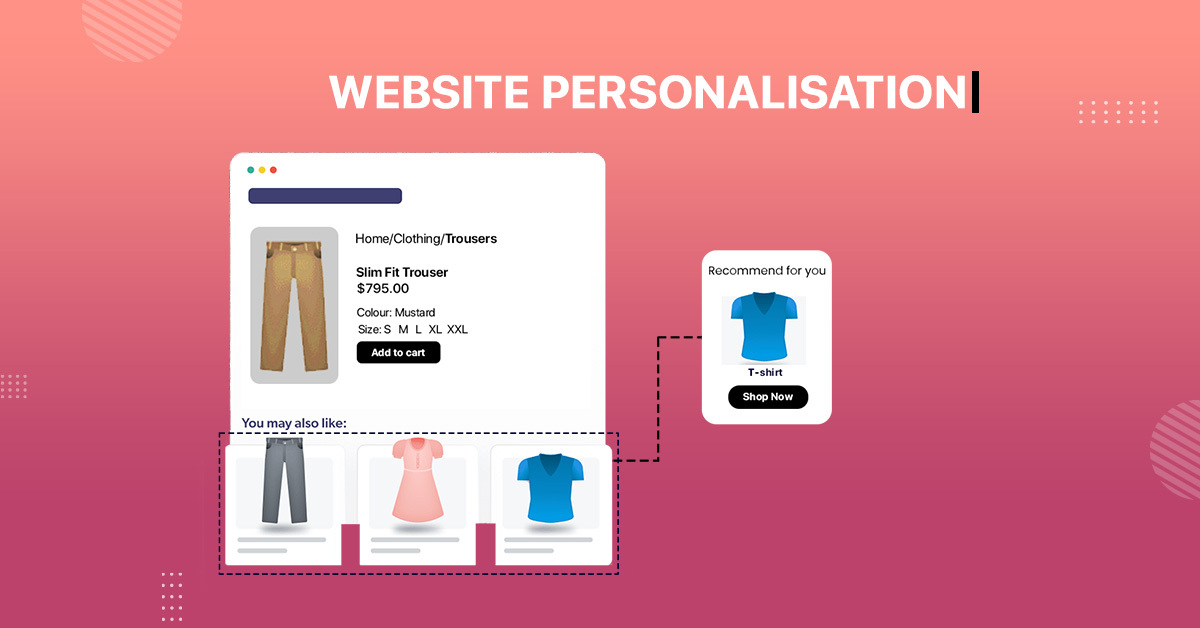Picture this: A customer comes to your website and fills her cart with products she loves. But when she’s about to check out, she changes her mind and leaves the cart behind. It’s like walking away from a full shopping cart in a physical store.
Cart Abandonment is a significant problem facing the e-commerce industry.
“Every year, an astounding $4.6 trillion worth of merchandise is abandoned in shoppers’ digital carts.”
Cart Abandonment leads to considerable losses to e-commerce businesses. Brands spend tons of money driving relevant audiences to their website and converting window shoppers into loyal customers, only to bear huge losses in high cart abandonment.
However, with personalisation, brands can overcome the problem of cart abandonment. A personalised customer experience is the difference between a visitor and a paying customer. Personalisation significantly improves conversion rates and helps brands reduce abandoned carts.
This blog talks about how personalising customer journeys at each stage of the customer lifecycle is the key to reducing cart abandonment. But before we start, let’s look at some cart abandonment stats.
8 Cart Abandonment Stats You Must Know
- According to a report by Baymard Institute, the average cart abandonment rate is almost 70%. This means that only three out of ten customers who add items to their carts complete their purchase.
- If we talk about the region-specific cart abandonment problem, the Asia-Pacific region, with an 82% cart abandonment rate, tops the chart.
- According to ContentSquare, customers aged 25-44 abandon their carts the most.
- 24% of shoppers abandon their carts at checkout because they don’t want to create an account.
- 22% of users abandon their carts because of an extended delivery time.
- 17% of shoppers do not complete their purchase because of a complicated checkout process.
- Bugs in websites also lead to cart abandonment, with 13% of shoppers dropping out without completing the checkout process.
- 9% of customers abandon their carts because of the absence of their favourable mode of payment.
Role of personalisation in reducing cart abandonment
Gone are the days when addressing customers by their names in emails was considered a personalised experience. Personalisation goes beyond that. Leveraging data to understand customers’ preferences and needs and delivering a tailored experience is what customers desire. By tailoring the shopping experience to the individual customer, e-commerce businesses can improve conversions.
Let’s look at how brands can use personalisation to improve cart abandonment rates.
1. Personalised Product Recommendations
One way to personalise the customer experience is by recommending products based on customers’ needs and preferences. Analysing customer shopping patterns and past purchases can help brands present tailored recommendations. This increases the likelihood of customers completing the purchase.
Brands can optimise their checkout page by displaying product recommendations and encouraging customers to buy. Moreover, sending personalised product recommendations in Email Marketing Campaigns, Push Notifications, WhatsApp, or other communication channels can be valuable in re-engaging customers and encouraging purchases.
2. Cart Recovery Automation
Reminding customers of the items they have left in their carts is another way of recovering abandoned carts. This can be done via cart recovery automation. It helps brands automatically trigger personalised cart recovery messages at specified intervals. Images and descriptions of the abandoned products can be included in the cart recovery message to remind customers to complete their purchases. Moreover, brands can offer discounts or free shipping to entice customers to return and complete their purchases.
WhatsApp has served as the best channel to recover abandoned carts. Reminding customers by sending a personalised WhatsApp message whenever a customer leaves without completing the purchase is a powerful method for recovering lost sales. Brands can also engage cart abandoners via Cart Abandonment Emails and Push Notifications.
“A report by Klaviyo suggests that cart abandonment email campaigns with multiple emails outperform those with a single email.”
3. Leveraging Exit Intent Pop-ups
Exit intent pop-ups are strategically triggered when a user is about to leave the website. It detects the cursor’s movement and triggers when the user is about to close the window. Exit Intent is one of the best ways to stop users from leaving your website.
Brands can trigger exit intent pop-ups whenever a customer tries to leave the website without completing the purchase. Offering discounts, limited-time offers, etc., encourage customers to reconsider their choice and finish the transaction. In addition, exit intent also serves as an automated data collection tool.
4. Simplify the Checkout Process
A complicated and time-consuming checkout process is a surefire way to turn potential customers away and leave their carts abandoned. To mitigate this issue, personalisation plays a crucial role in optimising the entire experience. By leveraging customer data and preferences, you can enhance the checkout process, making it smoother and more user-friendly.
One effective approach is to use personalisation to pre-fill essential customer information, such as shipping addresses or payment details. This information can be drawn from their previous orders or saved profiles. By doing so, you reduce customers’ frustration of typing the entire information again and save yourself from lost revenue in terms of cart abandonment.
Furthermore, you can offer tailored suggestions for additional products or services based on the items in their cart. This cross-selling or upselling strategy increases the order value and provides customers with a more personalised shopping experience.
5. Leverage the Power of User-generated Content
User-generated content or customer reviews is one of the most powerful tools for a marketer. Customers trust other customers when it comes to buying a product. Therefore, feedback from customers helps other customers decide whether to purchase or not.
Brands must leverage user-generated content, such as customer reviews or testimonials, to create trust in customers about their products and drive more sales. The personalised validation removes customers’ concerns regarding their purchase and increases the likelihood of a purchase.
6. Creating Urgency with Limited-time Offers
No one wants to miss out on a great deal. This is where limited-time offers come into play. They create a sense of urgency and nudge customers to complete the transaction as they fear missing out on fantastic offers.
Brands can automate exit-intent timer pop-ups that should be triggered just before the customer exits the site. Timer pop-ups containing the time left to grab the deal will excite the customers to complete the purchase before the offer expires.
Brands can also send personalised emails, SMS, WhatsApp, or Push notifications to remind customers of the ongoing offer. Such notifications can serve as a last-ditch effort to re-engage customers, offering them enticing incentives and ultimately leading to increased conversions and reduced cart abandonment.
7. Launching Retargeting Campaigns to Target Cart Abandoners
According to a report, retargeting ads can reduce cart abandonment rate by 6.5% and increase online sales by almost 20%. Customers who have viewed your products or added them to their carts are potential customers that can be easily converted.
Retargeting campaigns help customers remind about the forgotten carts and encourage them to complete the purchase. Retargeting such cart abandoners can help e-commerce businesses significantly reduce cart abandonment and recover lost sales. Retargeting also helps e-commerce brands stay top of mind for potential customers who leave their carts behind.
8. Automating Real-Time Cart Abandonment Pop-Ups
Real-time cart abandonment notifications work based on customers’ actions on the website. When the customer adds something to the cart, a product abandonment onsite notification is triggered, reminding them to complete the purchase.
Personalising these notifications with tailored offers can encourage customers to shop right away. In addition to this, addressing any concerns or providing additional information might promote the purchase. And using behavioral analytics can also improve the overall user experience.
9. Optimise the Mobile Experience
Mobile devices are omnipresent like that one song stuck in the head. The latest data from Statista projects that by 2023, the worldwide count of mobile devices in operations stands at almost 16 billion, surpassing the global population. People can’t keep their hands off their smartphones, making it the perfect way to reach them.
According to a report, 31% of customers prefer shopping in-app rather than in-store shopping. And 60% of consumers prefer mobile shopping apps over mobile sites because of better user experience. This makes it essential for brands to optimise the mobile experience to reduce cart abandonment and increase sales. Ensure your website or app is mobile-friendly, with an adaptable design, simple navigation, and a streamlined checkout process.
Concluding Remark
Personalisation is crucial in reducing cart abandonment in e-commerce, where $4.6 trillion worth of merchandise is abandoned annually. Personalisation involves recommending products based on customer preferences, using cart recovery automation, exit-intent pop-ups, simplifying the checkout process, and leveraging user-generated content. It also involves creating urgency with limited-time offers, retargeting campaigns, and optimising the mobile experience. In short, personalisation is essential for improving the customer experience and reducing cart abandonment rates.













